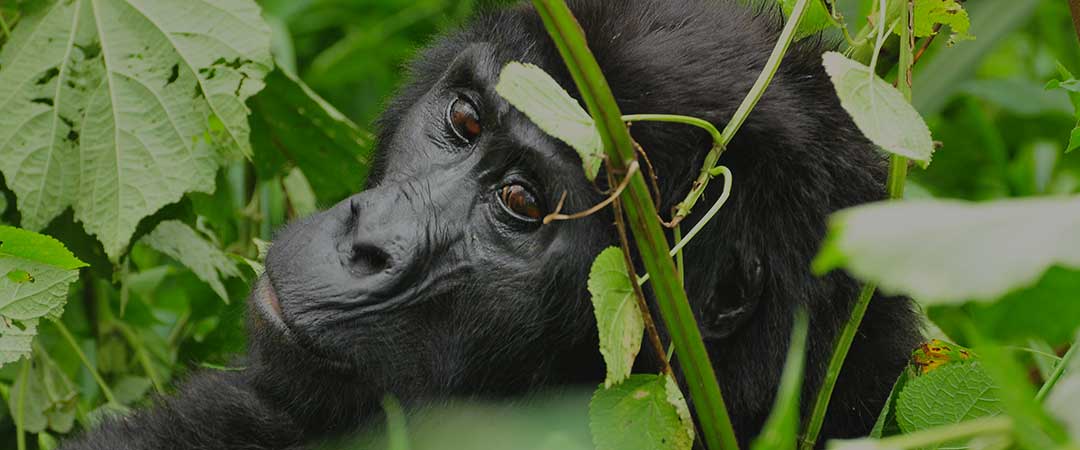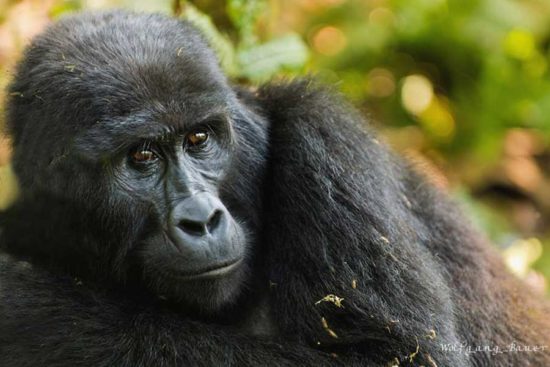The endangered Mountain Gorillas of Uganda won’t be found in any zoo in the world (they do not survive in captivity and there are no surviving mountain gorillas in zoos), you can only find them and see them in Africa, in the countries of Uganda, Rwanda, and the Democratic Republic of Congo. According to census data released by the Uganda Wildlife Authority (November 2012), there are only about 880 Mountain Gorillas left in the world and over 400 of those live in Bwindi Impenetrable Forest alone. Others can be found in Mgahinga Gorilla National Park in Uganda, Volcanoes National Park in Rwanda and Virunga National Park in the Democratic Republic of Congo.
The Mountain Gorillas were not known about by westerners until 1902. Rwanda was a German colony when a Captain von Berenge was climbing Mount Sabinyo on the Rwanda side with some friends and they were at the 9300 foot level and camped when a group of Mountain Gorillas was spotted and he shot two of them but could only retrieve one. It was a young male about 5 years old, 220 pounds and not too large, but larger than any apes the German had seen. Bones and skin were sent to Berlin where it was identified as a gorilla.
No one had thought that gorillas could exist in such high altitude and much colder climate than West Africa. The news of these gorillas drew hunters to the area, especially the Congo where they shot or captured Mountain Gorillas. Prince Wilhelm of Sweden shot 14 mountain gorillas in a 1920-1921 expedition to the area.
The Belgians established a preservations program for the Mountain Gorillas and so did the English in Uganda. In Uganda for a long time no one was even allowed to take visitors to view the Mountain Gorillas. In Kisoro, Walter Baumgartel was given permission to set up visits for travelers to his Travellers Rest Inn, a place you can still stay at today in Uganda. Baumgartel wrote the Book “Up among the Mountain Gorillas” which is about his time in Uganda and encounters with the giant apes of southern Uganda. It is a lovely book about man, an inn, the beauty of the Ugandan country side, and mostly about the Mountain Gorillas. Dian Fossey used to stay there on a regular basis and so did George Schaller to name just two.
Most Gorillas that you might have encountered in a zoo are from the lowlands of western Africa, the mountain gorillas are a subspecies called Gorilla beringei. The only place you can find them is in the wild in the Virunga areas of Rwanda in the Volcano Park of Rwanda, Virunga National Park in the Democratic Republic of Congo and in Uganda at Bwindi Impenetrable Forest National Park and Mgahinga Gorilla National Park. The parks are within 48 kilometers of each other. In Uganda and Rwanda the parks are easily accessed, in the Democratic Republic of Congo there is the problem of rebel activities and potential life-threatening danger to visitor due to the rebel activity.
The Gorillas are actually increasing in numbers due to the protection they are receiving from the Ugandan government which involved the communities surrounding the parks and gives them a portion of the 500 dollar Gorilla tracking (trekking) fees collected from foreign visitors to Bwindi and Mgahinga.
Mountain Gorillas Described
The fur of the Mountain Gorilla, often thicker and longer than that of other Gorilla species, enables them to live in colder temperatures. Gorillas can be identified by nose prints unique to each individual. Males usually weigh twice as much as the females, and this subspecies is on average the largest of all gorillas. Adult males have more pronounced bony crests on the top and back of their skulls, giving their heads a more conical shape. These crests anchor the powerful masseter muscles, which attach to the lower jaw. Adult females also have these crests, but they are less pronounced. Like all gorillas they feature dark brown eyes framed by a black ring around the iris. Adult males are called silverbacks because a saddle of gray or silver-colored hair develops on their backs with age.
The hair on their backs is shorter than on most other body parts, and their arm hair is especially long. Fully erect, males reach 1.9 m (6 ft 3 in) in height, with an arm span of 2.3 m (7 ft 7 in) and weigh of 220 kg (490 lb). The tallest silverback recorded was a 1.94 m (6 ft 4 in) individual shot in Alimbongo, northern Kivu in May 1938. There’s an unconfirmed record of another individual, shot in 1932, that was 2.06 m (6 ft 9 in) tall. The heaviest was a 1.83 m (6 ft) silverback shot in Ambam, Cameroon which weighed about 266 kg (590 lb). The Mountain Gorilla is primarily terrestrial and quadrupedal. However, it will climb into fruiting trees if the branches can carry its weight, and it is capable of running bipedally up to 6 m (20 ft). The young ones will play in trees like children. Like all great apes other than humans, its arms are longer than its legs. It moves by knuckle-walking (like the Common Chimpanzee, but unlike the Bonobo and both orangutan species), supporting its weight on the backs of its curved fingers rather than its palms.
The Mountain Gorilla is diurnal, most active between 6:00 a.m. and 6:00 p.m. with a nap around lunch time. Many of these hours are spent eating. Large quantities of food are needed to sustain its massive bulk. It forages in early morning, rests during the late morning and around midday, and in the afternoon it forages again before resting at night. Each gorilla builds a nest from surrounding vegetation to sleep in, constructing a new one every evening. Only infants sleep in the same nest as their mothers. They leave their sleeping sites when the sun rises at around 6 am, except when it is cold. The males’ strength is 10 times stronger than the toughest boxer, even on steroids. A silverback’s arms will stretch out seven feet. Mountain Gorillas have longer and darker hair than their lowland cousins since they live in colder climates at much higher altitudes.
Life cycle of Mountain Gorillas
Females become sexually mature at 7-8 years old, but do not start to breed until several years later. Males mature later than females, with few breeding before the age of 15 years. High infant mortality, a long gestation (8.5 months), a tendency to single births, and a prolonged period of maternal care mean that, on average, only one baby is reared in a 4-6 year period. Females generally give birth to only three or four surviving young during their reproductive life. The mortality rate for gorillas less than one year old is high, but for adults the rate is only 5%. In the wild, they might live 40 to 50 years old. In the United States, a captive gorilla was reported to have lived to the age of 54.
Mountain Gorillas Habitat and Diet
In Uganda there are two places where Mountain Gorillas may be found, one is Mgahinga Gorilla Park. A beautiful park and a part of the Virunga chain of volcanoes that stretches into the Democratic Republic of Congo and Rwanda and Bwindi Impenetrable Forest National Park, ranging in altitude from 2,200–4,300 metres (7,200–14,100 ft). The vegetation is very dense at the bottom of the mountains, becoming sparser at higher elevations, and the forests where the Mountain Gorillas lives are often cloudy, misty and cold. Mountain Gorillas are primarily herbivores; the majority of their diet is composed of the leaves, shoots and stems (85.8%) of 142 plant species. It also feeds on bark (6.9%), roots (3.3%), flowers (2.3%), and fruit (1.7%), as well as small invertebrates. (0.1%). Adult males can eat up to 34 kilograms (75 lb) of vegetation a day, while a female can eat as much as 18 kilograms (40 lb). Most mountain gorillas take a little nap around a lunch time.
Bwindi Impenetrable Forest contains the largest Mountain Gorilla Population with over 400 (November 2012). It is a primeval forest that is also called “Place of Darkness.” The canopy of the trees makes it dark within the forest. The altitudes of the forest are between 1,160 to 2,607 meters above sea level. Bwindi and Mgahinga each have different characteristics and similarities. Bwindi is not an extinct volcanic area while Mgahinga is.
The home range size (the area used by one group of gorillas during one year) is influenced by availability of food sources and usually includes several vegetation zones. There are ten identified distinct zones, including: the bamboo forests at 2,200–2,800 metres (7,200–9,200 ft); the Hagenia forests at 2,800–3,400 metres (9,200–11,200 ft); and the giant senecio zone at 3,400–4,300 metres (11,200–14,100 ft). The Mountain Gorilla spends most of its time in the Hagenia forests, where gallium vines are found year-round. All parts of this vine are consumed: leaves, stems, flowers, and berries. It travels to the bamboo forests during the few months of the year fresh shoots are available, and it climbs into subalpine regions to eat the soft centers of giant senecio trees.
They move daily to a different location to spend the night making nests from twigs and leaves. Some human have found them quite comfortable, even enough to fall asleep in.
Mountain Gorilla Social Structure
In the Virunga Mountain Gorillas, the average length of tenure for a dominant silverback is 4.7 years. 61% of groups are composed of one adult male and a number of females and 36% contain more than one adult male. The remaining gorillas are either lone males or exclusively male groups, usually made up of one mature male and a few younger males. Group sizes vary from five to thirty, with an average of ten individuals. A typical group contains: one silverback, who is the group’s undisputed leader; one or two blackbacks, who act as sentries; three to four sexually mature females, who are ordinarily bonded to the dominant silverback for life; and from three to six juveniles and infants. Most males, and about 60% of females, leave their natal group. Males leave when they are about 11 years old, and often the separation process is slow: they spend more and more time on the edge of the group until they leave altogether.
The dominant silverback generally determines the movements of the group, leading it to appropriate feeding sites throughout the year. He also mediates conflicts within the group and protects it from external threats. When the group is attacked by humans, leopards, or other gorillas, the silverback will protect them even at the cost of his own life. He is the center of attention during rest sessions, and young animals frequently stay close to him and include him in their games. If a mother dies or leaves the group, the silverback is usually the one who looks after her abandoned offspring, even allowing them to sleep in his nest. Experienced silverbacks are capable of removing poachers’ snares from the hands or feet of their group members.
When the dominant silverback dies or is killed by disease, accident, or poachers, the family group may be severely disrupted. Unless he leaves behind a male descendant capable of taking over his position, the group will either split up or be taken over in its entirety by an unrelated male. When a new silverback takes control of a group family, he may kill all of the infants of the dead silverback. This practice of infanticide is an effective reproductive strategy, in that the newly acquired females are then able to conceive the new male’s offspring. Infanticide has not been observed in stable groups.
Mountain Gorilla Behavior
Visitors to Bwindi Impenetrable Forest often ask “are mountain gorillas” dangerous? Although strong and powerful, gorillas are generally gentle and shy, besides the mountain gorillas that visitors see in Uganda are habituated. That means that they are accustomed to people, a process that takes about two years. Dian Fossey was against the visiting of mountain gorillas as is done today in Uganda. However it is also that money that helps to keep them from extinction since they are prospering and growing in number in recent years.
Aggression
Severe aggression is rare in stable groups, but when two Mountain Gorilla groups meet, the two silverbacks can sometimes engage in a fight to the death, using their canines to cause deep, gaping injuries. The entire sequence has nine steps: (1) progressively quickening hooting, (2) symbolic feeding, (3) rising bipedally, (4) throwing vegetation, (5) chest-beating with cupped hands, (6) one leg kick, (7) sideways running, two-legged to four-legged, (8) slapping and tearing vegetation, and (9) thumping the ground with palms to end display. Just recently two Silverbacks fought in Democratic Republic of Congo and rangers intervened.
The mountain gorillas live in groups that can vary in size from 2 to 30 to 40, but most often in groups of 11. There is no mating season and babies are born all year long. Males start breeding at about 15 years of age and females give birth from 10 to 12 years old. Females will give birth every two to three years giving 4 to 6 offspring during their lifespan. Males leave their group at about 11 years of age, while a little over half of the females will leave their group.
Gorilla Affiliation
The midday rest period is an important time for establishing and reinforcing relationships within the group. Mutual grooming reinforces social bonds, and helps keep hair free from dirt and parasites. It is not as common among gorillas as in other primates, although females groom their offspring regularly. Young gorillas play often and are more arboreal than the large adults. Playing helps them learn how to communicate and behave within the group. Activities include wrestling, chasing and somersault, and just playing around. The silverback and his females tolerate and even participate if encouraged.
Mountain Gorilla Vocalization
Twenty-five distinct vocalizations are recognized, many of which are used primarily for group communication within dense vegetation. Sounds classified as grunts and barks are heard most frequently while traveling, and indicate the whereabouts of individual group members. They may also be used during social interactions when discipline is required. Screams and roars signal alarm or warning, and are produced most often by silverbacks. Deep, rumbling belches suggest contentment and are heard frequently during feeding and resting periods. They are the most common form of intergroup communication.
Fears
For reasons unknown, Mountain Gorillas that have been studied appear to be naturally afraid of certain reptiles. Infants, whose natural behavior is to chase anything that moves, will go out of their way to avoid chameleons and caterpillars. Koko, the western lowland female gorilla (born July 4, 1971) trained in sign language, is able to understand more than 1,000 signs based on American Sign Language, and understand approximately 2,000 words of spoken English, is afraid of crocodiles and alligators, even though she was born in captivity and has never seen them. They are also afraid of water and will cross streams only if they can do so without getting wet (i.e. crossing over fallen logs). Dian Fossey observed and noted the Mountain Gorilla’s obvious dislike of rain, as well.
Mountain Gorilla Predators
The greatest threat to Mountain Gorillas is the encroachment of growing villages around them. There had been a slash and burn mentality and it was hard to see how large tracks of land should be left for Gorillas, it is through an educational process by the Uganda Wildlife Authority and cash incentives to the community through tourism that the gorillas in Uganda are not as threatened by poachers as they might be in the Democratic Republic of Congo. They are also threatened by diseases that humans may bring to the park. That is why Uganda Wildlife Authority has strict rules in place to prevent the spreading of disease from humans to Mountain Gorillas.




